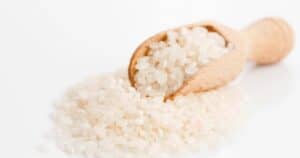Imagine walking into a bustling sushi restaurant, the air filled with the sweet scent of vinegared rice and fresh fish. Have you ever wondered what makes that rice so sticky and delicious? It’s not just any rice; it’s sushi rice, crafted with care and precision. The way it’s prepared can transform a simple meal into a culinary adventure.
Overview Of Sushi Rice
Sushi rice is special. It’s sticky and flavorful, perfect for sushi rolls or nigiri. Understanding how to prepare it can make a big difference in your sushi experience. Here are the important details about sushi rice.
Ingredients
- Japanese Short-Grain Rice: This rice is also called “sushi rice.” It’s important for making sushi. I find it in grocery stores, usually labeled clearly.
- Rice Vinegar: This ingredient gives the rice its unique taste. It’s mixed with sugar and salt to make sushi vinegar, which helps with seasoning.
- Sugar: Sugar is typically added to the rice vinegar. It balances the sourness and makes the rice even tastier.
- Salt: Salt adds flavor and helps the rice stay fresh. I like to season it just right for the best taste.
- Kombu (Optional): Adding kombu while cooking can enhance the flavor. It’s a type of seaweed. Some people like it, but others might skip it.
- Rinsing the Rice: I start by rinsing the rice with cold water. This step removes extra starch. It helps keep the rice from getting sticky or clumpy.
- Cooking the Rice: The next step is cooking the rice. It’s best to use a 1:1 water to rice ratio. I can cook it on the stovetop, in a rice cooker, or even a pressure cooker. Each method has its own charm.
- Mixing in the Sushi Vinegar: After cooking, I let the rice cool a little. Then, I mix in the sushi vinegar. This step is key. It helps the rice achieve the right flavor and texture.
Trying different ingredients and techniques can be fun. Maybe you’ll discover a new favorite way to prepare sushi rice! Each person might have their twist, so don’t be afraid to experiment a bit.
Essential Ingredients For Sushi Rice
Making sushi rice involves a couple of key ingredients. These ingredients bring out the flavors and give the rice its unique texture. Let’s look at what you need.
Short-Grain Rice
Japanese short-grain rice is the star of sushi. It’s often called “sushi rice.” I love it because it’s sticky due to its high starch content. This stickiness helps the rice hold together in sushi rolls and nigiri.
- Types of rice: Other rice types like long-grain rice don’t work well. Their texture just isn’t the same.
- Quality: Using good quality rice makes a noticeable difference. I suggest looking for brands that specifically say “sushi rice” on the package.
Vinegar Mixture
The vinegar mixture gives sushi rice its special taste. This mixture is usually a combo of rice vinegar, sugar, and salt. It sounds simple, but it plays a big role in the flavor.
- Rice Vinegar: This gives the rice a tangy flavor. You can find it in most grocery stores.
- Sugar: This adds a hint of sweetness. It helps balance the sourness of the vinegar. The amount can be adjusted based on your taste.
- Salt: Salt enhances all the flavors. Just the right amount can make a big difference in taste.
Mixing these ingredients with cooked rice is important. It’s likely that the rice should be warm but not too hot when you mix it in. I find that this helps the flavors soak in nicely.
Preparing Sushi Rice
Preparing sushi rice involves important steps. Each step shapes the rice’s texture and flavor. Following these techniques ensures successful sushi rice.
Rinsing The Rice
Rinsing the rice is an essential step. It likely helps remove extra starch and impurities. This keeps the rice from becoming mushy when mixed with vinegar. Here’s how I rinse the rice:
- I place the rice in a sieve or colander.
- I run cold tap water over it until the water runs clear.
- Gently rubbing the grains helps remove particles stuck to them.
This step creates a better base for sushi rice.
Soaking The Rice
Soaking makes the rice absorb water evenly. This step likely increases the weight by 1.25 to 1.30 times the original amount. It makes the rice feel powdery when I rub the grains between my fingers. To soak the rice, I do the following:
- I add water to the rinsed rice.
- I let it soak for about 30 minutes to 1 hour.
This soaking ensures the rice cooks perfectly and is delicious.
Cooking The Rice
Cooking the rice comes next. Proper cooking brings out the rice’s unique flavor and stickiness. Here’s how I cook the rice:
- I add the soaked rice to a rice cooker with the right amount of water.
- I switch it on and let it cook until it beeps.
- If I’m cooking on the stove, I bring it to a boil, then reduce to low heat, covering it for about 20 minutes.
The cooked rice is likely fluffy and light.
Seasoning Sushi Rice
Seasoning sushi rice is an important step for great flavor. It involves a few key techniques. Let’s jump into some tasty details.
Adding Vinegar
Creating the vinegar mixture is crucial. Here’s what I suggest for a balanced flavor:
- Rice Vinegar: Use about 1/3 cup of rice vinegar. It adds the right tang.
- Sugar: Mix in 3 tablespoons of sugar, making it sweet.
- Salt: Add 1 teaspoon of salt for seasoning.
Heat this mixture gently until the sugar dissolves. Let it cool afterward. Mixing the vinegar evenly into the rice helps bring out the best taste.
Cooling The Rice
Cool sushi rice carefully for the best results. Here’s what I do:
- Cool Down: After cooking, let the rice sit covered for about 10 minutes. This helps the rice finish cooking and get sticky.
- Fan It: If I can, I use a fan or a piece of cardboard to lightly blow cool air onto the rice. This step helps it cool faster and gives it a nice shine.
- Gentle Mixing: Use a spatula or a rice paddle to gently fold the cooled rice. This moves the rice around without squishing it too much.
Cooling the rice well ensures it has the right texture for sushi rolls. It’s likely the extra care makes a big difference in taste.
I think following these steps can lead to some really delicious sushi.
Common Mistakes To Avoid
Sushi rice preparation is all about details, and avoiding mistakes helps make it perfect. Here are some common problems and how to fix them.
- Incorrect Water Ratio: Using the wrong amount of water leads to either undercooked or mushy rice. The best water-to-rice ratio is 1:1.1 to 1:1.25 for Japanese short-grain rice. New-crop rice likely needs a 1:1 ratio. Older rice might require a bit more water.
- Insufficient Rinsing: Rinsing rice is key to getting rid of extra starch. Rinse for 1-2 minutes until the water runs clear. Not rinsing enough can create sticky or mushy rice, which doesn’t roll well.
- Incorrect Cooking Method: Cooking rice properly is super important. You can use a stovetop, rice cooker, or Instant Pot, but the rice must cook fully and cool quickly. If it’s cooked too soft, mixing it with sushi vinegar becomes tricky.
Conclusion
Mastering sushi rice preparation is an art that greatly enhances your sushi-making experience. By focusing on the quality of the rice and the right techniques, you can create the perfect base for your rolls.
Paying attention to the details like rinsing and cooling the rice properly can make all the difference in texture and flavor. Avoiding common mistakes ensures that your sushi rice turns out just right every time.
With practice and patience, you’ll find that perfect sushi rice is within your reach, elevating your homemade sushi to a whole new level. Enjoy the process and happy sushi making!





